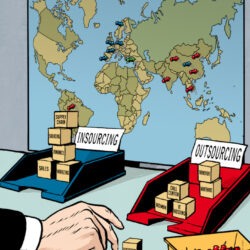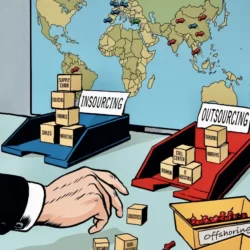Supply chain executives’ ambitions extend further than end-to-end visibility

Less than 30% of internationally operating companies currently have end-to-end supply chain visibility. That is according to research by Supply Chain Media and Buck Consultants International among 123 supply chain executives. But those executives do have very big plans, it emerged during the webinar in which Patrick Haex and Carlo Peters presented the survey results. ‘70% are aiming for end-to-end supply chain orchestration by 2027. That’s very ambitious.’
By Marcel te Lindert
Many companies have made progress in decentralizing their supply chains. That was the main conclusion from the survey that Supply Chain Media and Buck Consultants International presented last year. ‘Many companies have opted for a more regional approach. For example, because they want to reduce their dependence on China or shorten their global supply chains. But we have definitely not seen a reduction in the complexity of these supply chains,’ states Patrick Haex, Managing Partner at Buck.
That is one of the reasons Supply Chain Media and Buck decided to investigate end-to-end supply chain visibility & control this year: do companies have the right tools to make the right decisions? Haex points to the ongoing turbulence, from geopolitical conflicts to local port strikes. ‘Since the outbreak of the pandemic, everyone has been striving for more resilience and we have been talking about the importance of end-to-end supply chain visibility. So why is adoption still lagging behind expectations?’
Sound business case
Of the 123 supply chain executives surveyed for the study, only 30% currently have end-to-end supply chain visibility. But the majority of the respondents aspire to it. ‘In fact, 70% aspire to end-to-end supply chain orchestration by 2027. They not only want up-to-date information about their supply chain, but also to be able to use that information to drive their supply chain. Visibility is great, but not enough. Ultimately, it should lead to better and faster decision-making,’ says Haex.
The majority of supply chain executives see end-to-end supply chain visibility as a licence to operate. It is a skill they think they need and also has benefits such as higher service levels, Haex concludes based on the survey. ‘But if you want to sell a visibility project internally, you must be able to prove that it saves costs. It’s all about a sound business case.’
Fragmented IT landscape
The fact that only 30% say they have end-to-end supply chain visibility does not mean the rest are not taking steps in this area. They often start with visibility at transport level by using platforms that show, for example, when their sea freight and air freight shipments will arrive. ‘But many companies also have central planning hubs where they make forecasts, optimize stocks and manage suppliers,’ Haex states. ‘End-to-end supply chain visibility & control is all about connecting those two worlds. Some companies in high-tech and healthcare have already taken that step, but most are still working on it.’
The main barrier preventing adoption of end-to-end supply chain visibility & control is the fragmented IT landscape. Many companies have multiple, often outdated ERP systems that are not harmonized. Quality of master data is another issue, as is the complexity of implementation. ‘In the past, companies had two options: those who had sufficient scale and could afford the investment could choose to set something up themselves. The other option was outsourcing to a 4PL or a company specializing in business process outsourcing. But now we see more and more companies opting for a hybrid variant. They want to keep control of the data and technology themselves, but look for an external partner to do the work.’
Outsourcing logistics
Another theme in the survey is logistics outsourcing. Many companies have engaged an external partner for warehousing and transport to cut costs or focus on core activities. ‘These are anything but surprising conclusions,’ acknowledges Carlo Peters, Principal Consultant at Buck. ‘But the study shows that there are even more reasons for outsourcing. Such as the flexibility of logistics service providers to absorb peaks and troughs, or their ability to facilitate future growth.’
Looking towards 2027, companies would like to see their relationships with their logistics service providers change. They want a relationship that is more focused on value creation rather than minimum rates. ‘We foresee a shift from a transactional relationship with logistics service providers to a strategic one. In conjunction with this, we see a desire to reduce the number of logistics service providers. Companies prefer to have fewer partners, so they can enter into strategic partnerships with them,’ Peters says.
Focus on value creation
That desire may stem from the current situation. Companies are satisfied with the operational performance of their logistics service providers, but would also like them to have a proactive attitude and the ability to continuously improve. ‘These are precisely the elements that companies expect in a strategic relationship. They are also dissatisfied with logistics service providers’ progress in digitalization and network optimization. Logistics service providers will have to invest in their competences in this area,’ Peters comments.
But companies themselves also have work to do. If they want to build strategic relationships with their logistics service providers, they will have to focus on long-term rather than short-term goals. And focus not on costs but on value creation, and be prepared to sign contracts for seven or ten years instead of two or three. ‘In addition, a strategic relationship requires harmonization and standardization of processes,’ Peters emphasizes. ‘This also changes the selection process. We often see that Procurement has different interests from Supply Chain. So does it really make sense for Procurement to lead the selection process?’










